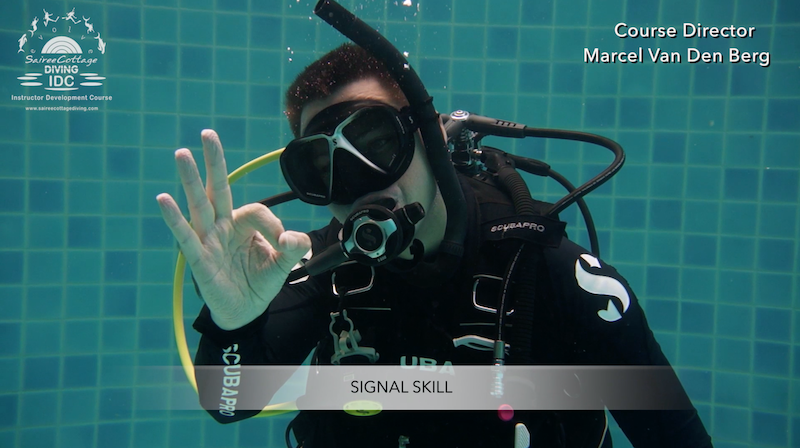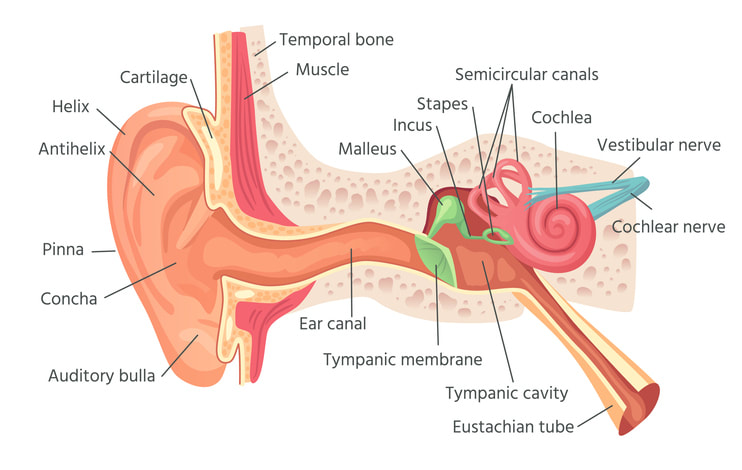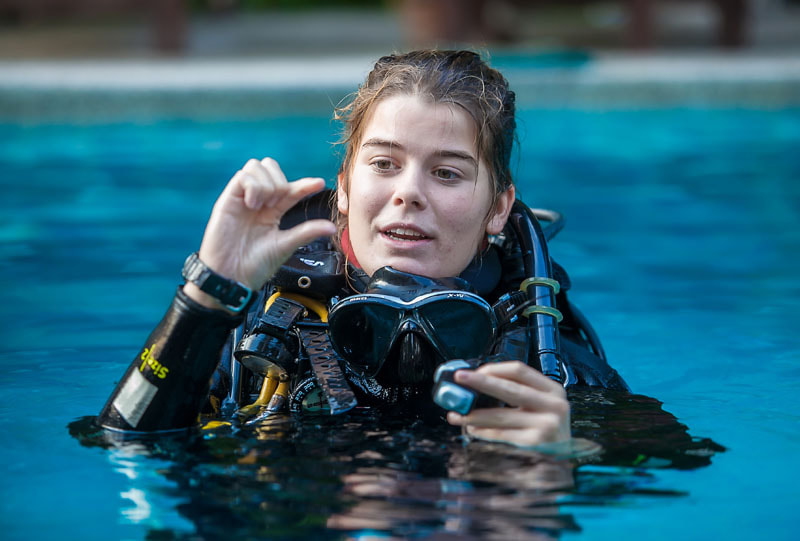Scuba Diving Hand Signals - How Divers Communicate Underwater
Scuba Diving Hand Signals are used by divers to communicate underwater. These Scuba Hand Signals are easy to learn and understand. You don’t need to know ASL deaf sign language to scuba dive. Everyone can do it easily by learning these common scuba diving hand signals.
Why Scuba Hand Signals, why not just talk underwater?
You actually can talk underwater. The deeper you go to higher your tone will be and at one point you will be sounding like Donald Duck. So why is it that we need to use Scuba Diving Hand Signals if we can talk underwater?
This has more to do with your ability to hear underwater compared to your ability to talk underwater. Sound travels in waves around 4 times faster in water than it does in air. In the air, the sound will hit our inner ear and because we are made from an average of 65% water, the sound can hit the ossicle bones which sends signals to the brain to decipher the language.
Learn more about dive physics here
This has more to do with your ability to hear underwater compared to your ability to talk underwater. Sound travels in waves around 4 times faster in water than it does in air. In the air, the sound will hit our inner ear and because we are made from an average of 65% water, the sound can hit the ossicle bones which sends signals to the brain to decipher the language.
Learn more about dive physics here
If sounds travel through water, it can’t hit the ossicle bones in the inner ear as that is also made from water. It will now hit your mastoid bone of the skull right behind your ears and make it vibrate. In other words, you use your skull to listen underwater instead of your ears. The mastoid bone bypasses the ear canal to signal the brain and activates both ears at once. This makes it hard to understand where the sound is coming from underwater. This is why we need Scuba Diving hand Signals to communicate underwater.
Learn more about dive physiology here
Learn more about dive physiology here
Difference between Scuba Diving hand Signals and Sign Language of the Deaf
Sign languages are full-fledged natural languages with their own grammar and lexicon. This makes it possible to speak full sentences. Scuba Diving Hand Signals are shorter more simplified scuba signals that can mean multiple words or meanings with a single signal.
When do you learn Scuba Diving Hand Signals?
We recommend you to learn the most common scuba hand signals as soon as you can and before your scuba diving courses. But don’t worry if you haven’t prepared as you will also learn scuba diving hand signals in your PADI Open Water Water Diver course or any other beginner scuba diving courses from other organizations.
You will learn these scuba hand signals from your PADI Open Water Manual, the PADI Video’s, and from your Diving Instructor. Most Dive Instructors teach the Scuba Diving Hand Signals a bit in the classroom and mostly during the PADI Confined Water Dive 1.
You will learn these scuba hand signals from your PADI Open Water Manual, the PADI Video’s, and from your Diving Instructor. Most Dive Instructors teach the Scuba Diving Hand Signals a bit in the classroom and mostly during the PADI Confined Water Dive 1.
Your Diving Instructor will repeat these scuba signals throughout your PADI Open Water course to ensure repetition and retaining the signals. A funny note is that many scuba divers tend to unknowingly use scuba hand signals in their daily lives.
Common Scuba Hand Signals
Here we will show the most common scuba hand signals you can expect to see and use while diving. From the famous ok signal, scuba diving hand signals for air pressure to emergency scuba signals.
Full Scuba Diving Hand Signal Video:
Full Scuba Diving Hand Signal Video:
OK Sign Hand Signal
The OK sign is instantly recognized as the famous scuba diving signal. The OK signal is maybe the most used signal in scuba diving. The OK signal can mean 2 things, the Question: Are you ok? And the answer: I am ok.
Diving Signal: SOMETHING IS WRONG WITH THE EARS
Having ear problems is very common with beginner scuba divers. To solve an ear problem you need to equalize your ears while scuba diving. For some people this is easy, but for others, this can be hard. Knowing this hand signal will help you to tell your Dive Instructor, Divemaster, or Dive Guide that you have a problem Equalizing your Ears.
Check out our PADI Medical Form page and find out if you need to check your ears with a doctor before scuba diving.
Check out our PADI Medical Form page and find out if you need to check your ears with a doctor before scuba diving.
Almost all divers can equalize their ears if they know the proper technique. Many people, struggle with equalizing their ears, usually because of bad training, and not allowing enough time for new divers to equalize their ears. If you want to know more about some amazing and easy techniques to equalize your ears while scuba diving then check this video here:
Diving Signal: SOMETHING IS WRONG WITH THE STOMACH
Having a Stomach issue is not good to have on land, but it can be even more uncomfortable underwear. With this signal, you can tell your buddy or dive leader that there is something wrong with your stomach underwater.
Diving Signal: PUKE
Puking is never nice, not above, and not underwater. We highly recommend you to cancel the dive and return to the surface, if you feel sick and feel you need to puke. This is however not always possible and in the worst-case scenario, we heard about stories from people puking up underwater through their regulators. Knowing this Puking Scuba Hand Signal can help you to alert other divers about your condition.
Diving Signal: STOP
The Diving Signal STOP is used when a diver wants you to stop in whatever you are doing underwater. This signal is important as it can stop potential dangerous activities while scuba diving. The stop signal is also common when other divers swim too fast.
Diving Signal: COME CLOSER
This signal is very handy when other scuba divers are too far away from each other. Just signal to come closer to reunite with your buddy, get closer to the coral or your Dive Instructor, Divemaster, and/or Dive Guide.
Diving Signal: HAVE MORE DISTANCE
Sometimes scuba divers are too close to each other or way too close to aquatic life. Just use the scuba diving hand signal: Have More Distance to move them away.
Diving Signal: BUDDY UP
One of the most important things in scuba diving is to stay close to your buddy. You can dive solo with the PADI Self-reliant Diving certification, but that takes more training. In general, we highly recommend you always dive with a buddy. We do understand that with so much to see underwater you can quickly lose your distance between each other. This scuba signal will bring you back together.
Diving Signal: COME TOGETHER
The Come Together hand signal is very similar to the buddy up signal and it means that you come together with your buddy, another diver, aquatic life, or any object underwater.
Diving Signal: HAVE MORE SPACE BETWEEN EACH OTHER
As much as we always promote to stay close to your buddy, we sometimes see scuba divers almost clued together. This is not a good diving experience and with the signal: Have more space between each other we try to get you apart.
Diving Signal: SIT ON YOUR KNEES
This scuba signal is used a lot by dive instructors asking their students to sit on their knees. Most likely diving instructors ask this when practicing diving skills in confined water and sometimes even the open water if on a sandy bottom with no chance of hurting any aquatic life.
Diving Signal: STAND ON YOUR LEGS
This scuba diving hand signal is used when someone wants you to stand on your legs on the bottom of the pool, confined open water, or the bottom of the sea. It is of course very important that you check for any aquatic life before you give this signal to your diving students or fellow scuba diver.
Diving Signal: SLOW DOWN
The Slow Down Hand Signal can be very handy. You are supposed to do anything slowing when scuba diving. Moving fast can deplete your air much quicker. You also won’t see much aquatic life when you dive fast. This is because you scare it away and it is hard to see any details moving fast. With this scuba hand signal, you can signal your buddy to slow down and enjoy the dive better.
Diving Signal: REMEMBER
The remember scuba signal is used many times by Dive Instructors and Divemasters. This diving signal can help students to remember things while they are scuba diving. The remember signal is one of the most used scuba diving hand signals by Diving Instructors and Divemasters.
Diving Signal: CUT
his sounds a bit like a scary hand signal, but dive instructors and Divemasters use it to finish (cut) a scuba skill when the performance requirements have been met. It is also used by PADI Examiners during the PADI IE when they have seen enough and in most cases will now reward you the PADI Scuba Dive Instructor Diploma.
Besides all the teaching signals, it is also used as a signal to cut something underwater like a fishing line to net with your dive tool, scissors, or dive knife.
Besides all the teaching signals, it is also used as a signal to cut something underwater like a fishing line to net with your dive tool, scissors, or dive knife.
Diving Signal: CONTINUE
The Continue hand signal is usually used by scuba instructors that want you to do more of a scuba skill or work more on your swimming/buoyancy. The continue scuba hand signal means to keep doing what you are doing underwater.
Diving Signal: REPEAT
The Repeat hand signal is also commonly used by dive instructors. They use this signal to ask you to repeat something and in most cases that will be a diving skill. Or you might do a great move underwater and someone asks you to do it again with this diving hand signal.
Diving Signal: GO UP
The going up signal is commonly mistaken with the OK sign while scuba diving. On land, we like to use the Thumbs Up signal all the time when we are happy or agree on something. But the thumbs-up signal in scuba diving means: Going Up. We commonly use this scuba signal to ascent at the end of a dive.
Diving Signal: GO DOWN
If you want anyone to go down or descent on a scuba dive you show them this signal. Go down means descending in diving and can be very important when divers start to float up. In many cases, scuba divers don’t know that they are floating up, so having a buddy reminding them to go down with this signal can be very handy.
Diving Signal: BREATH IN AND OUT
Feeling relaxed and calm while scuba diving has all to do with your breathing. It is very important to breathe slowly and deeply while scuba diving. Also during many diving skills, you need to breathe in and out the right way. This signal can help to remind you or others to breathe in and out.
Diving Signal: OUT OF AIR
This is not one of the most positive signals, but the Out of Air Scuba Hand Signal is one of the most important ones. In the unlikely event, you might run out of air, you can use this to signal your buddy or any other diver that you are out of air and that you need to share air with an alternate air source. Knowing the Out of Air signal can potentially save your life is it ever happens.
Diving Signal: WHAT IS YOUR AIR?
Scuba Diving Hand Signals for Air Pressure are very important to make sure you don't run Out of Air while one a dive. In this video, we show you all the Scuba Diving Hand Signals for Air Pressure.
The scuba hand signals air left should be asked every 5 to 10 minutes while scuba diving. I recommend using this signal to ask your buddy what his/her air is every 10 minutes on a dive and your buddy doing the same back to you. You should still always check your air frequently during the dive, I recommend every 5 minutes a quick look at your air gauge and every 10 minutes check your buddy or/and diving students by giving this scuba hand signal.
The scuba hand signals air left should be asked every 5 to 10 minutes while scuba diving. I recommend using this signal to ask your buddy what his/her air is every 10 minutes on a dive and your buddy doing the same back to you. You should still always check your air frequently during the dive, I recommend every 5 minutes a quick look at your air gauge and every 10 minutes check your buddy or/and diving students by giving this scuba hand signal.
After someone asks you for your air, you should give them the right air signal back. What is very important is that many scuba divers use different hand signals. Not asking and checking new diver air signals can be a very dangerous mistake. It is not a problem at all that some people use different scuba diving and signals than others, but it is very important to agree on any scuba hand signals before a dive, especially air signals.
Diving Signal: LOOKING
The looking signal can be used to show a diver where to look. There are many points of interest underwater to look at. Many times I see an amazing aquatic animal and I signal to my buddy to look at it and vice versa. We also sometimes point out looking at something potentially dangerous to make sure we avoid it.
Diving Signal: INFLATE THE BCD A LITTLE BIT
This is a very common and important signal given by Diving Instructors, Divemasters, and Dive Guides. Especially if you are a new scuba diver you will see this signal a lot as you are getting a feeling for your buoyancy control. We prefer to adjust our buoyancy with our lungs, but a little bit of air in your BCD can help.
Diving Signal: DEFLATE YOUR BCD
If you are a new scuba diver then you will see this diving hand signal a lot by your dive instructor. Controlling your buoyancy is not easy when you first try out scuba diving and a lot of new divers tend to float up to the surface. This can be for different reasons like inhaling too much, no enough weights, too excited underwater, kicking up, but mostly it is because of too much air in the BCD. Knowing to recognize the Deflate Your BCD scuba signal can help you to deflate in time and stop the ascent.
Learn more about Inflating and Deflating the BCD on the Surface
Learn more about Inflating and Deflating the BCD on the Surface
Diving Signal: BEST DEFLATE POSITION
Floating up is a big problem for beginner scuba divers. Most of the time it is caused by putting too much air in the BCD. A lot of diving instructors will signal you to release air from the BCD when this happens. However, in many cases, the student, diver, or you try hard to deflate the BCD but it doesn’t work.
This is because you are trying to deflate your scuba BCD in the wrong position. To effectively deflate a scuba BCD you need to be in a vertical position. This scuba diving hand signal will remind you to go into the best deflate position.
This is because you are trying to deflate your scuba BCD in the wrong position. To effectively deflate a scuba BCD you need to be in a vertical position. This scuba diving hand signal will remind you to go into the best deflate position.
Diving Signal: PROPER WAY TO GET DOWN
This signal is given when someone wants you to go down. In most cases this means just to slowly exhale to descent again and if that doesn’t work try to deflate your BCD in the proper position to go down. In most cases, you just have to exhale while scuba diving if you are relaxed.
Diving Signal: SWIMMING
Scuba Diving is more about having neutral buoyancy and hover underwater to look at amazing aquatic life. However, you do need to swim sometimes get to another location. To swim while scuba diving is as easy as kicking your legs and fins underwater. You can use this swimming signal to remind someone to use the scissors kicks or the more advanced frog kicks to swim while scuba diving.
Scuba Diving Hand Signals Conclusion
Scuba Hand Signals are an amazing way how divers communicate underwater. Scuba Diving hand Signals are not hard to learn and we hope that this article helped you in learning these scuba signals. Please share this page with anyone interested in learning scuba diving hand signals and I wish you the best scuba diving adventures!
|
|
|
|
Marcel van den Berg
PADI Platinum Course Director
PADI Platinum Course Director
SCUBA DIVING TIPS
Privacy Policy
Disclaimer
As an Amazon Associate I earn from qualifying purchases.
All content on this website and URL are owned by Sairee Cottage Diving PADI 5-Star IDC Center S-36452
Copyright 2017 - 2022 | All Rights Reserved
Disclaimer
As an Amazon Associate I earn from qualifying purchases.
All content on this website and URL are owned by Sairee Cottage Diving PADI 5-Star IDC Center S-36452
Copyright 2017 - 2022 | All Rights Reserved






